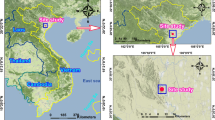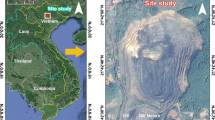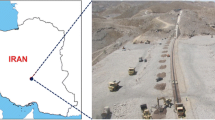Abstract
Blasting operation is considered as one of the cheapest methods to break the rock into small pieces in surface and underground mines. Ground vibration is a side effect of blasting and can result in damage to, or failure of, nearby structures. Therefore, it is imperative to predict ground vibration in the blasting sites. The primary objective of this paper is to propose a new model to predict ground vibration based on itemset mining (IM) and neural networks (NN), called IM–NN. It is worth mentioning that no research has tested the efficiency of IM–NN to predict ground vibration yet. IM–NN is composed of three steps; firstly, frequent and confident patterns (itemsets) were extracted by using IM. Secondly, for each test instance, the most appropriate instances were selected based on the extracted patterns. Thirdly, NN was only trained by the selected instances. To achieve the objective of this research, a dataset including 92 instances was collected from blasting events of two surface mines in Iran, Kerman province. To demonstrate the acceptability of IM–NN, the classical NN as well as several empirical equations were also developed in this study. The results indicated that IM–NN with the correlation squared (R2) of 0.944 has better performance than NN with R2 of 0.898 and may be a promising alternative to the NN for predicting ground vibration. Thus, the use of IM was a good idea to optimize and improve the NN performance.

















Similar content being viewed by others
References
Khandelwal M, Singh TN (2007) Evaluation of blast-induced ground vibration predictors. Soil Dyn Earthq Eng 27:116–125
Khandelwal M, Singh TN (2009) Prediction of blast-induced ground vibration using artificial neural network. Int J Rock Mech Min Sci 46:1214–1222
Segarra P, Domingo JF, López LM, Sanchidrián JA, Ortega MF (2010) Prediction of near field overpressure from quarry blasting. Appl Acoust 71:1169–1176
Verma AK, Singh TN (2013) Comparative study of cognitive systems for ground vibration measurements. Neural Comput Appl 22(Suppl 1):S341–S350
Hasanipanah M et al (2017) Development of a precise model for prediction of blast-induced flyrock using regression tree technique. Environ Earth Sci 76(1):27
Hasanipanah M, Amnieh HB, Arab H, Zamzam MS (2018) Feasibility of PSO–ANFIS model to estimate rock fragmentation produced by mine blasting. Neural Comput Appl 30(4):1015–1024
Singh TN, Krishnan PR (2000) Ground vibrations due to blasting and its environmental impacts. IM and EJ, pp 144–149
Rai R, Singh TN (2004) A new predictor for ground vibration prediction and its comparison with other predictors. Ind J Eng Mater Sci 11:178–184
Singh AP, Singh TN (2006) Assessing instability of Coal Mine waste dump. Indian Mineral Ind J, pp 113–118
Monjezi M, Singh TN, Khandelwal M, Sinha S, Singh V, Hossein I (2006) Prediction and analysis of blast parameters using artificial neural network. Noise Vib World 37:8–16
Hasanipanah M, Monjezi M, Shahnazar A, Jahed Armaghani D, Farazmand A (2015) Feasibility of indirect determination of blast induced ground vibration based on support vector machine. Measurement 75:289–297
Amiri M, Bakhshandeh Amnieh H, Hasanipanah M, Mohammad Khanli L (2016) A new combination of artificial neural network and K-nearest neighbors models to predict blast-induced ground vibration and air-overpressure. Eng Comput 32:631–644
Hasanipanah M, Shirani Faradonbeh R, Bakhshandeh Amnieh H, Jahed Armaghani D, Monjezi M (2017) Forecasting blast induced ground vibration developing a CART model. Eng Comput 33(2):307–316
Hasanipanah M, Bakhshandeh Amnieh H, Khamesi H, Jahed Armaghani D, Bagheri Golzar S, Shahnazar A (2018) Prediction of an environmental issue of mine blasting: an imperialistic competitive algorithm-based fuzzy system. Int J Environ Sci Technol 15(3):551–560
Jahed Armaghani D, Hasanipanah M, Bakhshandeh Amnieh H, Mohamad ET (2018) Feasibility of ICA in approximating ground vibration resulting from mine blasting. Neural Comput Appl 29(9):457–465
Duvall WI, Petkof B (1959) Spherical propagation of explosion generated strain pulses in rock. US Bureau of Mines Report of Investigation 5483
Ambraseys NR, Hendron AJ (1968) Dynamic behavior of rock masses: rock mechanics in engineering practices. Wiley, London
Indian Standard Institute (1973) Criteria for safety and design of structures subjected to underground blast. ISI Bull IS-6922
Singh TN, Kanchan R, Saigal K, Verma AK (2004) Prediction of P-wave velocity and anisotropic properties of rock using artificial neural networks technique. J Sci Ind Res 63(1):32–38
Khandelwal M, Kankar PK (2011) Prediction of blast-induced air overpressure using support vector machine. Arab J Geosci 4:427–433
Verma AK, Singh TN (2011) Intelligent systems for ground vibration measurement: a comparative study. Eng Comput 27(3):225–233
Hajihassani M, Jahed Armaghani D, Sohaei H, Tonnizam Mohamad E, Marto A (2014) Prediction of airblast-overpressure induced by blasting using a hybrid artificial neural network and particle swarm optimization. Appl Acoust 80:57–67
Hasanipanah M, Golzar SB, Larki IA, Maryaki MY, Ghahremanians T (2017) Estimation of blast-induced ground vibration through a soft computing framework. Eng Comput 33(4):951–959
Taheri K, Hasanipanah M, Bagheri Golzar S, Majid MZA (2017) A hybrid artificial bee colony algorithm-artificial neural network for forecasting the blast-produced ground vibration. Eng Comput 33(3):689–700
Xue X (2019) Neuro-fuzzy based approach for prediction of blast-induced ground vibration. Appl Acoust 152:73–78
Fisne A, Kuzu C, Hudaverdi T (2011) Prediction of environmental impacts of quarry blasting operation using fuzzy logic. Environ Monit Assess 174(1–4):461–470
Ghasemi E, Ataei M, Hashemolhosseini H (2012) Development of a fuzzy model for predicting ground vibration caused by rock blasting in surface mining. J Vib Control 19(5):755–770
Monjezi M, Hasanipanah M, Khandelwal M (2013) Evaluation and prediction of blast-induced ground vibration at Shur River Dam, Iran, by artificial neural network. Neural Comput Appl 22:1637–1643
Jahed Armaghani D, Momeni E, Khalil Abad SVAN, Khandelwal M (2015) Feasibility of ANFIS model for prediction of ground vibrations resulting from quarry blasting. Environ Earth Sci 74:2845–2860
Dindarloo SR (2015) Prediction of blast-induced ground vibrations via genetic programming. Int J Min Sci Technol 25(6):1011–1015
Ram Chandar K, Sastry VR, Hegde C, Shreedharan S (2016) Prediction of peak particle velocity using multi regression analysis: case studies. Geomech Geoeng: Int J. http://dx.doi.org/10.1080/17486025.2016.1184763
Khandelwal M, Jahed Armaghani D, Shirani Faradonbeh R, Yellishetty M, Abd Majid MZ, Monjezi M (2017) Classification and regression tree technique in estimating peak particle velocity caused by blasting. Eng Comput 33:45–53
Nguyen H, Bui XN, Bui HB, Cuong DT (2019) Developing an XGBoost model to predict blast-induced peak particle velocity in an open-pit mine: a case study. Acta Geophys. https://doi.org/10.1007/s11600-019-00268-4
Arthur CK, Temeng VA, Ziggah YY (2019) Novel approach to predicting blast-induced ground vibration using Gaussian process regression. Eng Comput. https://doi.org/10.1007/s00366-018-0686-3
Nguyen H, Drebenstedt C, Bui XN, Bui DT (2019) Prediction of blast-induced ground vibration in an open-pit mine by a novel hybrid model based on clustering and artificial neural network. Nat Resour Res. https://doi.org/10.1007/s11053-019-09470-z
Khandelwal M, Monjezi M (2013) Prediction of flyrock in open pit blasting operation using machine learning method. Int J Min Sci Technol 23(3):313–316
Khandelwal M, Monjezi M (2013) Prediction of backbreak in open-pit blasting operations using the machine learning method. Rock Mech Rock Eng 46:389–396
Amiri M, Mohammad-Khanli L (2017) Survey on prediction models of applications for resources provisioning in cloud. J Netw Comput Appl 82(C):93–113
Singh TN, Singh V (2005) An intelligent approach to prediction and control ground vibration in mines. Geotech Geol Eng 23:249–262
Ainalis D et al (2017) Modelling the source of blasting for the numerical simulation of blast-induced ground vibrations: a review. Rock Mech Rock Eng 50:171–193
Langefors U, Kihlstrom B (1978) The modern technique of rock blasting. Wiley, New York
Blair DP (1993) Blast vibration control in the presence of delay scatter and random fluctuations between blast holes. Int J Numer Anal Methods Geomech 17(2):95–118
Bhandari S (1997) Engineering rock blasting operations. A.A. Balkema, Netherlands
Afrouz A, Hassani FP, Ucar R (1988) An investigation into blasting design for mining excavations. J Min Sci Technol 7:45–62
Rustan A (1992) Burden, spacing and bore hole diameter at rock blasting. Int J Surf Min Reclam 6:141–149
Adhikari GR (1999) Burden calculation for partially changed blast design conditions. Int J Rock Mech Min Sci 36(2):253–256
Wiss JF, Linehan PW (1978) Control of vibration and air noise from surface coal mines—III. Bureau of Mines, US, Report No. OFR 103(3), p 79
Siskind DE, Stagg MS, Kopp JW, Dowding CH (1980) Structure response and damage produced by ground vibration from surface mine blasting. USBMRI 8507:74
Yan X et al (2005) Summarizing itemset patterns: a profile-based approach. In: Proceedings of the eleventh ACM SIGKDD international conference on Knowledge discovery in data mining, Chicago, Illinois, USA
Shalabi LA, Shaaban Z (2006) Normalization as a preprocessing engine for data mining and the approach of preference matrix. In: 2006 International conference on dependability of computer systems. Szklarska Poreba, pp 207–214
Hasanipanah M et al (2017) Developing a new hybrid-AI model to predict blast-induced backbreak. Eng Comput 33(3):349–359
Ramírez-Gallego S et al (2016) Data discretization: taxonomy and big data challenge. Wiley Interdiscip Rev: Data Min Knowl Discov 6(1):5–21
Amiri M, Mohammad-Khanli L, Mirandola R (2018) A sequential pattern mining model for application workload prediction in cloud environment. J Netw Comput Appl 105:21–62
Domínguez-Olmedo JL et al (2011) A deterministic approach to association rule mining without attribute discretization. Springer, Berlin
Vannucci M, Colla V (2004) Meaningful discretization of continuous features for association rules mining by means of a SOM. In: ESANN, Citeseer
Han J, Pei J, Kamber M (2011) Data mining: concepts and techniques. Elsevier, Amsterdam
Dharsandiya AN, Patel MR (2016) A review on Frequent Itemset Mining algorithms in social network data. In: Wireless communications, signal processing and networking (WiSPNET), international conference on IEEE
Agrawal R, Imieliński T, Swami A (1993) Mining association rules between sets of items in large databases. In: ACM sigmod record. ACM
Fournier-Viger P, Lin JCW, Vo B, Chi TT, Zhang J, Le HB (2017) A survey of itemset mining. Wiley Interdiscip Re: Data Min Knowl Discov 7(4):e1207
Borgelt C (2012) Frequent itemset mining. Wiley Interdiscip Rev: Data Min Knowl Discov 2(6):437–456
Agrawal R, Srikant R (1994) Fast algorithms for mining association rules. In: Proceedings of 20th international conference very large data bases, VLDB
Tan PN, Steinbach M, Kumar V (2005) Association analysis: basic concepts and algorithms. In: Introduction to data mining, pp 327–414
Hasanipanah M, Naderi R, Kashir J, Noorani SA, Aaq Qaleh AZ (2017) Prediction of blast produced ground vibration using particle swarm optimization. Eng Comput 33(2):173–179
Qi C, Fourie A, Ma G, Tang X (2018) A hybrid method for improved stability prediction in construction projects: a case study of stope hangingwall stability. Appl Soft Comput 71:649–658
Qi C, Chen Q, Fourie A, Zhang Q (2018) An intelligent modelling framework for mechanical properties of cemented paste backfill. Miner Eng 123:16–27
Hasanipanah M, Armaghani DJ, Amnieh HB, Majid MZA, Tahir MMD (2017) Application of PSO to develop a powerful equation for prediction of flyrock due to blasting. Neural Comput Appl 28(1):1043–1050
Asteris PG, Nozhati S, Nikoo M, Cavaleri L, Nikoo M (2019) Krill herd algorithm-based neural network in structural seismic reliability evaluation. Mech Adv Mater Struct. https://doi.org/10.1080/15376494.2018.1430874
Asteris PG, Nikoo M (2019) Artificial bee colony-based neural network for the prediction of the fundamental period of infilled frame structures. Neural Comput Appl. https://doi.org/10.1007/s00521-018-03965-1
Qi C, Chen Q, Dong X, Zhang Q, Yaseen ZM (2019) Pressure drops of fresh cemented paste backfills through coupled test loop experiments and machine learning techniques. Powder Technol. https://doi.org/10.1016/j.powtec.2019.11.046
Keshtegar B, Hasanipanah M, Bakhshayeshi I, Sarafraz ME (2019) A novel nonlinear modeling for the prediction of blastinduced airblast using a modified conjugate FR method. Measurement 131:35–41
Qi C, Chen Q, Fourie A, Tang X, Zhang Q, Dong X, Feng Y (2019) Constitutive modelling of cemented paste backfill: a data-mining approach. Constr Build Mater 197:262–270
Lu X, Hasanipanah M, Brindhadevi K, Amnieh HB, Khalafi S (2019) ORELM: a novel machine learning approach for prediction of flyrock in mine blasting. Nat Resour Res. https://doi.org/10.1007/s11053-019-09532-2
Qi C, Fourie A (2019) Cemented paste backfill for mineral tailings management: review and future perspectives. Miner Eng 144:106025
Zhou J, Nekouie A, Arslan CA, Pham BT, Hasanipanah M (2019) Novel approach for forecasting the blast-induced AOp using a hybrid fuzzy system and firefly algorithm. Eng Comput. https://doi.org/10.1007/s00366-019-00725-0
Zhou J, Li C, Arslan CA, Hasanipanah M, Amnieh HB (2019) Performance evaluation of hybrid FFA-ANFIS and GA-ANFIS models to predict particle size distribution of a muck-pile after blasting. Eng Comput. https://doi.org/10.1007/s00366-019-00822-0
Gao W, Alqahtani AS, Mubarakali A, Mavaluru D, Khalafi S (2019) Developing an innovative soft computing scheme for prediction of air overpressure resulting from mine blasting using GMDH optimized by GA. Eng Comput 35(131):1–8
Luo Z, Hasanipanah M, Amnieh HB, Brindhadevi K, Tahir MM (2019) GA-SVR: a novel hybrid data-driven model to simulate vertical load capacity of driven piles. Eng Comput. https://doi.org/10.1007/s00366-019-00858-2
Hasanipanah M, Bakhshandeh Amnieh H (2020) Developing a new uncertain rule-based fuzzy approach for evaluating the blast-induced backbreak. Eng Comput. https://doi.org/10.1007/s00366-019-00919-6
Hasanipanah M, Bakhshandeh Amnieh H (2020) A fuzzy rule-based approach to address uncertainty in risk assessment and prediction of blast-induced Flyrock in a quarry. Nat Resour Res. https://doi.org/10.1007/s11053-020-09616-4
Friedman M (1937) The use of ranks to avoid the assumption of normality implicit in the analysis of variance. J Am Stat Assoc 32:675–701
Demšar J (2006) Statistical comparisons of classifiers over multiple data sets. J Mach Learn Res 7:1–30
Acknowledgements
This research was supported by Grant 98/1664 in Arak University.
Author information
Authors and Affiliations
Corresponding author
Ethics declarations
Conflict of interest
The authors declare that they have no conflict of interest.
Additional information
Publisher's Note
Springer Nature remains neutral with regard to jurisdictional claims in published maps and institutional affiliations.
Rights and permissions
About this article
Cite this article
Amiri, M., Hasanipanah, M. & Bakhshandeh Amnieh, H. Predicting ground vibration induced by rock blasting using a novel hybrid of neural network and itemset mining. Neural Comput & Applic 32, 14681–14699 (2020). https://doi.org/10.1007/s00521-020-04822-w
Received:
Accepted:
Published:
Issue Date:
DOI: https://doi.org/10.1007/s00521-020-04822-w




